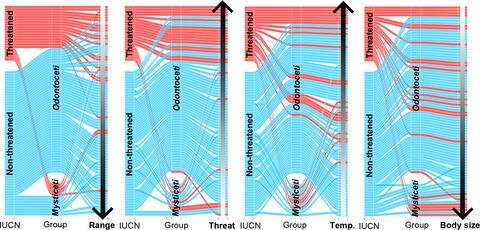当前位置:
X-MOL 学术
›
Glob. Change Biol.
›
论文详情
Our official English website, www.x-mol.net, welcomes your
feedback! (Note: you will need to create a separate account there.)
Geographic range size, water temperature, and extrinsic threats predict the extinction risk in global cetaceans
Global Change Biology ( IF 10.8 ) Pub Date : 2022-08-12 , DOI: 10.1111/gcb.16385 Chuanwu Chen 1 , Thomas A Jefferson 2 , Bingyao Chen 1 , Yanping Wang 1
Global Change Biology ( IF 10.8 ) Pub Date : 2022-08-12 , DOI: 10.1111/gcb.16385 Chuanwu Chen 1 , Thomas A Jefferson 2 , Bingyao Chen 1 , Yanping Wang 1
Affiliation

|
Despite the fact that cetaceans provide significant ecological contributions to the health and stability of aquatic ecosystems, many are highly endangered with nearly one-third of species assessed as threatened with extinction. Nevertheless, to date, few studies have explicitly examined the patterns and processes of extinction risk and threats for this taxon, and even less between the two subclades (Mysticeti and Odontoceti). To fill this gap, we compiled a dataset of six intrinsic traits (active region, geographic range size, body weight, diving depth, school size, and reproductive cycle), six environmental factors relating to sea surface temperature and chlorophyll concentration, and two human-related threat indices that are commonly recognized for cetaceans. We then employed phylogenetic generalized least squares models and model selection to identify the key predictors of extinction risk in all cetaceans, as well as in the two subclades. We found that geographic range size, sea surface temperature, and human threat index were the most important predictors of extinction risk in all cetaceans and in odontocetes. Interestingly, maximum body weight was positively associated with the extinction risk in mysticetes, but negatively related to that for odontocetes. By linking seven major threat types to extinction risk, we further revealed that fisheries bycatch was the most common threat, yet the impacts of certain threats could be overestimated when considering all species rather than just threatened ones. Overall, we suggest that conservation efforts should focus on small-ranged cetaceans and species living in warmer waters or under strong anthropogenic pressures. Moreover, further studies should consider the threatened status of species when superimposing risk maps and quantifying risk severity. Finally, we emphasize that mysticetes and odontocetes should be conserved with different strategies, because their extinction risk patterns and major threat types are considerably different. For instance, large-bodied mysticetes and small-ranged odontocetes require special conservation priority.
中文翻译:

地理范围大小、水温和外在威胁预测全球鲸类动物的灭绝风险
尽管鲸类动物对水生生态系统的健康和稳定做出了重大的生态贡献,但许多鲸类动物仍处于高度濒危状态,近三分之一的物种被评估为濒临灭绝。然而,迄今为止,很少有研究明确检查过该分类群灭绝风险和威胁的模式和过程,在两个亚群(Mysticeti 和 Odontoceti)之间的研究更少。为了填补这一空白,我们编制了一个包含六个内在特征(活动区域、地理范围大小、体重、潜水深度、学校规模和生殖周期)、六个与海面温度和叶绿素浓度相关的环境因素以及两个人类特征的数据集。 - 鲸目动物普遍认可的相关威胁指数。然后,我们采用系统发育广义最小二乘模型和模型选择来确定所有鲸类以及两个亚群中灭绝风险的关键预测因子。我们发现地理范围大小、海面温度和人类威胁指数是所有鲸类和齿鲸类灭绝风险的最重要预测因素。有趣的是,最大体重与神秘动物的灭绝风险呈正相关,但与齿鲸的灭绝风险呈负相关。通过将七种主要威胁类型与灭绝风险联系起来,我们进一步揭示了渔业兼捕是最常见的威胁,但在考虑所有物种而不仅仅是受威胁的物种时,某些威胁的影响可能被高估。全面的,我们建议保护工作应侧重于生活在温暖水域或强烈人为压力下的小型鲸类和物种。此外,在叠加风险图和量化风险严重程度时,进一步的研究应考虑物种的受威胁状态。最后,我们强调应该用不同的策略保护神秘动物和齿鲸,因为它们的灭绝风险模式和主要威胁类型有很大不同。例如,大型神秘动物和小型齿鲸需要特别保护。我们强调应采用不同的策略保护神秘动物和齿动物,因为它们的灭绝风险模式和主要威胁类型有很大不同。例如,大型神秘动物和小型齿鲸需要特别保护。我们强调应采用不同的策略保护神秘动物和齿动物,因为它们的灭绝风险模式和主要威胁类型有很大不同。例如,大型神秘动物和小型齿鲸需要特别保护。
更新日期:2022-08-12
中文翻译:

地理范围大小、水温和外在威胁预测全球鲸类动物的灭绝风险
尽管鲸类动物对水生生态系统的健康和稳定做出了重大的生态贡献,但许多鲸类动物仍处于高度濒危状态,近三分之一的物种被评估为濒临灭绝。然而,迄今为止,很少有研究明确检查过该分类群灭绝风险和威胁的模式和过程,在两个亚群(Mysticeti 和 Odontoceti)之间的研究更少。为了填补这一空白,我们编制了一个包含六个内在特征(活动区域、地理范围大小、体重、潜水深度、学校规模和生殖周期)、六个与海面温度和叶绿素浓度相关的环境因素以及两个人类特征的数据集。 - 鲸目动物普遍认可的相关威胁指数。然后,我们采用系统发育广义最小二乘模型和模型选择来确定所有鲸类以及两个亚群中灭绝风险的关键预测因子。我们发现地理范围大小、海面温度和人类威胁指数是所有鲸类和齿鲸类灭绝风险的最重要预测因素。有趣的是,最大体重与神秘动物的灭绝风险呈正相关,但与齿鲸的灭绝风险呈负相关。通过将七种主要威胁类型与灭绝风险联系起来,我们进一步揭示了渔业兼捕是最常见的威胁,但在考虑所有物种而不仅仅是受威胁的物种时,某些威胁的影响可能被高估。全面的,我们建议保护工作应侧重于生活在温暖水域或强烈人为压力下的小型鲸类和物种。此外,在叠加风险图和量化风险严重程度时,进一步的研究应考虑物种的受威胁状态。最后,我们强调应该用不同的策略保护神秘动物和齿鲸,因为它们的灭绝风险模式和主要威胁类型有很大不同。例如,大型神秘动物和小型齿鲸需要特别保护。我们强调应采用不同的策略保护神秘动物和齿动物,因为它们的灭绝风险模式和主要威胁类型有很大不同。例如,大型神秘动物和小型齿鲸需要特别保护。我们强调应采用不同的策略保护神秘动物和齿动物,因为它们的灭绝风险模式和主要威胁类型有很大不同。例如,大型神秘动物和小型齿鲸需要特别保护。











































 京公网安备 11010802027423号
京公网安备 11010802027423号